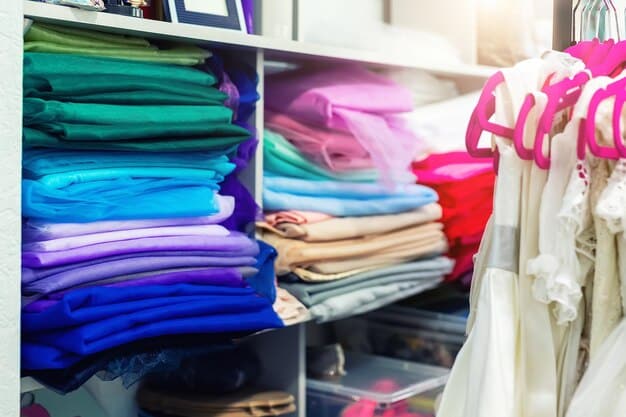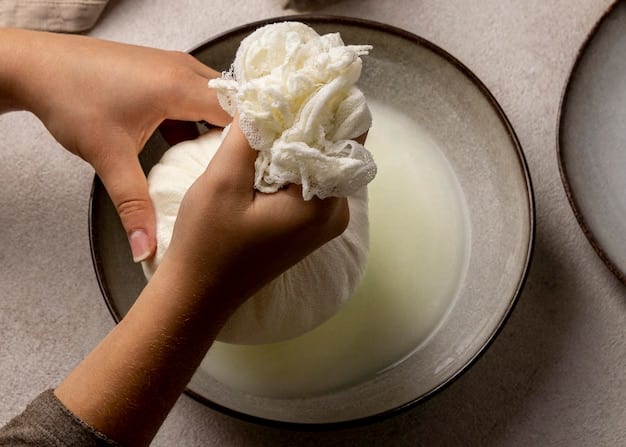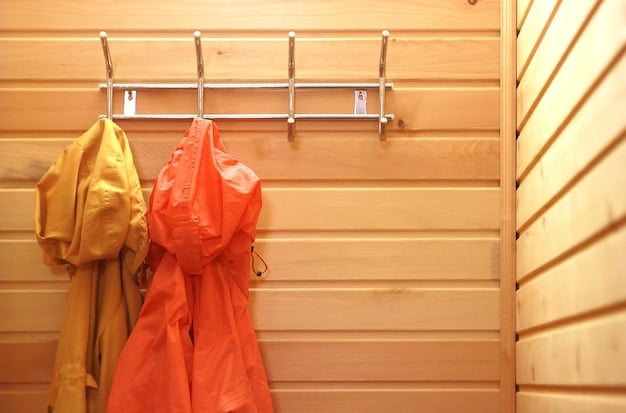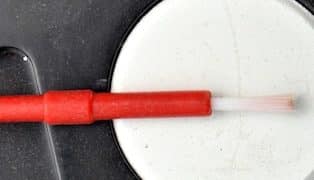How to Care for Your Clothes: Expert Tips for Longevity

Caring for your clothes properly can significantly extend their lifespan, saving you money and reducing environmental impact through mindful washing, proper storage, and timely repairs.
Want to keep your favorite clothes looking great for years to come? How to Care for Your Clothes to Make Them Last Longer: Expert Tips will guide you through the best practices for washing, storing, and repairing your garments, ensuring they stay in top condition.
Gentle Washing Techniques
One of the most crucial aspects of extending the life of your clothes is how you wash them. Harsh washing methods can damage fibers, fade colors, and cause wear and tear. Adopting gentle washing techniques can make a significant difference in the longevity of your wardrobe.
Hand Washing Delicate Items
Certain fabrics, like silk, lace, and items with intricate embellishments, benefit from hand washing. This prevents them from being damaged in the washing machine.
- Use a mild detergent specifically designed for delicate fabrics.
- Fill a basin with cool water and add the detergent, mixing gently.
- Submerge the item and gently swirl it around, avoiding harsh scrubbing.
- Rinse thoroughly with cool water until no soap remains.
Machine Washing with Care
When using a washing machine, always select the appropriate settings to minimize damage.
- Use a gentle cycle with cold water to prevent fading and shrinkage.
- Turn clothes inside out to protect the outer layer from abrasion.
- Use a mesh laundry bag for delicate items to prevent snagging.
- Avoid overloading the machine to ensure clothes are properly cleaned and rinsed.
By adopting these gentle washing techniques, you can significantly reduce the wear and tear on your clothes and keep them looking newer for longer. Remember to always check the care label for specific instructions before washing any garment.

Effective Stain Removal Methods
Stains are inevitable, but knowing how to treat them properly can prevent them from becoming permanent. Quick action and the right stain removal methods are key to preserving your clothes.
Treating Stains Promptly
The sooner you address a stain, the easier it is to remove. Delaying treatment can allow the stain to set, making it much harder to eliminate.
- Blot the stain gently with a clean cloth or paper towel, working from the outside in to prevent spreading.
- Avoid rubbing the stain, as this can further embed it into the fabric.
- Identify the type of stain to choose the appropriate removal method.
Common Stain Removal Solutions
Different stains require different solutions. Here are a few effective methods for dealing with common types of stains.
- For oil-based stains, apply cornstarch or baking soda to absorb the oil before washing.
- For ink stains, use rubbing alcohol on a cotton ball, blotting gently until the ink is lifted.
- For blood stains, rinse the item in cold water immediately and apply hydrogen peroxide if necessary.
- For coffee or tea stains, soak the item in a solution of vinegar and water before washing.
By treating stains promptly and using appropriate removal solutions, you can prevent them from ruining your clothes. Always test stain removers on an inconspicuous area first to ensure they don’t damage the fabric.
Proper Drying Practices
How you dry your clothes is just as important as how you wash them. Improper drying can lead to shrinkage, fading, and damage to delicate fabrics. Following proper drying practices can help maintain the quality of your clothes.
Air Drying Benefits
Air drying is the gentlest method for drying clothes. It minimizes wear and tear and helps preserve the color and shape of your garments.
- Hang clothes on a clothesline or drying rack away from direct sunlight to prevent fading.
- Turn clothes inside out to protect the outer layer from the sun.
- Use padded hangers to prevent shoulder indentations.
Tumble Drying Tips
If you use a tumble dryer, select the appropriate settings to minimize damage.
- Use a low heat setting to prevent shrinkage and damage to fibers.
- Remove clothes promptly after drying to prevent wrinkles.
- Use dryer balls to help fluff clothes and reduce drying time.
- Avoid over-drying clothes, as this can weaken the fibers and cause static cling.
Adopting proper drying practices ensures that your clothes maintain their shape, color, and overall quality. Air drying is generally preferred, but when using a tumble dryer, careful settings and monitoring can make a significant difference.
Strategic Storage Solutions
Proper storage is essential for maintaining the condition of your clothes when they’re not being worn. Poor storage can lead to wrinkles, fading, and even pest infestations. Using strategic storage solutions can help protect your wardrobe.
Organizing Your Closet
A well-organized closet not only makes it easier to find what you need, but it also helps protect your clothes from damage.
- Hang delicate items and those prone to wrinkling, such as dresses, suits, and blouses.
- Fold knitwear and items that can stretch out of shape if hung, such as sweaters and t-shirts.
- Use slim, space-saving hangers to maximize closet space and prevent shoulder bumps.
Seasonal Storage Techniques
When storing clothes for extended periods, such as seasonal items, take extra precautions to protect them.
- Wash or dry clean items before storing them to remove any dirt or odors that could attract pests.
- Store clothes in airtight containers or garment bags to protect them from dust, moisture, and pests.
- Add cedar chips or lavender sachets to repel moths and other insects.
Implementing strategic storage solutions helps keep your clothes in excellent condition, preventing damage and ensuring they’re ready to wear when you need them. A well-organized closet and careful seasonal storage can significantly extend the life of your garments.

Repairing and Altering Clothes
Instead of discarding clothes with minor damage, consider repairing or altering them. This sustainable practice not only saves you money but also extends the life of your favorite items. Basic repair skills can be invaluable in maintaining your wardrobe.
Basic Sewing Skills
Learning a few basic sewing skills can help you fix minor tears, reattach buttons, and reinforce seams.
- Keep a sewing kit on hand with needles, thread, scissors, and other essential supplies.
- Learn how to sew a straight stitch, backstitch, and whipstitch for basic repairs.
- Use online tutorials or take a sewing class to improve your skills.
Professional Alterations
For more complex repairs or alterations, consider taking your clothes to a professional tailor.
- Alterations can help you customize the fit of your clothes, making them more comfortable and stylish.
- Professional tailors can repair damaged zippers, replace linings, and make other significant repairs.
- Investing in alterations can extend the life of your clothes and improve their overall appearance.
Repairing and altering clothes not only extends their lifespan but also promotes sustainability by reducing textile waste. Whether you learn basic sewing skills or rely on a professional tailor, these practices can significantly enhance your wardrobe.
Choosing Quality Materials
The quality of the materials used in your clothes plays a significant role in their longevity. Investing in well-made garments from durable fabrics can save you money in the long run by reducing the need for frequent replacements.
Durable Fabric Options
Certain fabrics are known for their durability and resistance to wear and tear.
- Cotton is a versatile and breathable fabric that is relatively durable.
- Linen is a strong and absorbent fabric that becomes softer with each wash.
- Wool is a naturally resilient fabric that resists wrinkles and odors.
- Polyester and nylon are synthetic fabrics that are highly durable and resistant to stretching and shrinking.
Assessing Garment Construction
In addition to fabric type, the construction of a garment is crucial for its longevity.
- Check the seams to ensure they are securely stitched and reinforced.
- Look for quality zippers and buttons that are durable and easy to use.
- Examine the lining to ensure it is well-constructed and made from a durable material.
By choosing quality materials and assessing garment construction, you can invest in clothes that are built to last. Paying attention to these details ensures that your wardrobe remains stylish and functional for years to come.
| Key Point | Brief Description |
|---|---|
| 🧼 Gentle Washing | Use delicate cycles for machine washing or hand wash fragile items. |
| ⚠️ Stain Treatment | Address stains quickly using appropriate methods to prevent setting. |
| ☀️ Proper Drying | Air dry when possible, or use low heat in the dryer to avoid damage. |
| 🪡 Repair & Alter | Repair or alter clothes instead of discarding them to extend their life. |
Frequently Asked Questions
▼
It depends on the garment and how often you wear it. Items like underwear and workout clothes should be washed after each wear, while jeans and sweaters can be washed less frequently, typically after several wears.
▼
Air drying is generally better for your clothes as it is gentler and reduces the risk of shrinkage and damage. However, if you need to tumble dry, use a low heat setting to minimize wear and tear.
▼
To prevent fading, wash clothes inside out, use cold water, and avoid direct sunlight when drying. Consider using detergents specifically designed to protect colors and avoid over-washing.
▼
Wash or dry clean your clothes before storing them. Use airtight containers or garment bags to protect them from dust, moisture, and pests. Store them in a cool, dry place away from direct sunlight.
▼
Treat the stain as soon as possible. Blot the stain gently, avoiding rubbing, and use appropriate stain removal solutions based on the type of stain. Always test the solution on an inconspicuous area first.
Conclusion
By incorporating these expert tips into your routine, you can significantly extend the life of your clothes, save money, and reduce your environmental impact. From gentle washing techniques to strategic storage solutions, mindful clothing care is a worthwhile investment in the longevity of your wardrobe.





